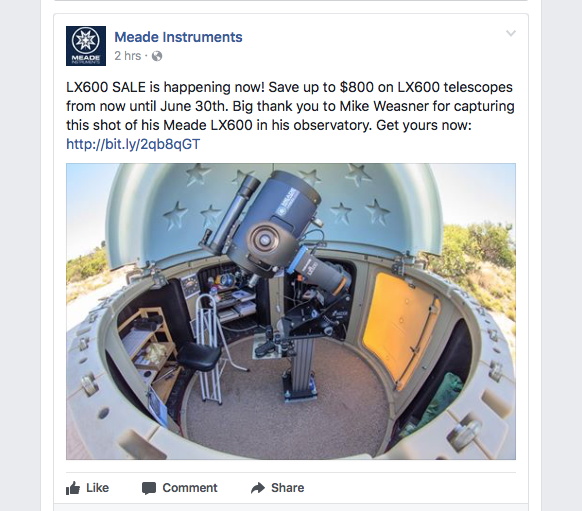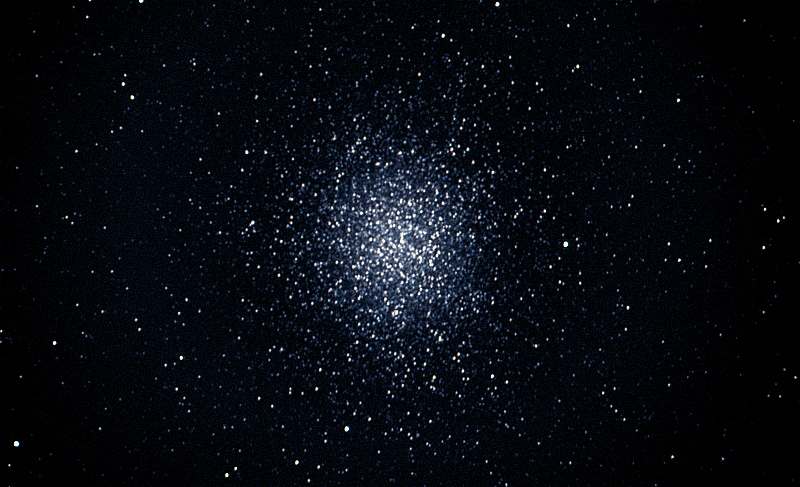DSLR imaging: Crescent Moon, Globular Star Clusters
Posted: 28 May 2017
On Tuesday, 23 May 2017, Meade Instruments posted this photo of my observatory and 12' LX600 telescope on their Facebook page:

Smoke from a wildfire was seen from Oracle for a few days. The Pinal Fire is about 70 miles north. A smoke plume was visible during the day from Oracle State Park on Tuesday:

That evening clouds came in.
The sky had a lot of smoke visible from the Pinal Fire during the day on Wednesday, 24 May. This photo was taken with an iPhone 6s Plus through sunglasses used as a polarizing filter and shows the smoke in the sky and the smoke plume on the horizon at lower right:

Even our web cam showed the smokey sky:

Clouds and wind returned late Wednesday afternoon. Missed out on an excellent pass of the International Space Station (ISS) that night. A Red Flag Wind Warning was in effect for Thursday, 25 May, with continued cloudiness. Friday, 26 May, was clear but windy (Red Flag Warning continued). Saturday, 27 May, dawned clear and calm, but some wind came up mid-day.
|
Open: Saturday, 27 May 2017, 1856 MST Temperature: 91°F |
Session: 1115 Conditions: Clear |
Equipment Used:
12" f/8 LX600 w/StarLock
2" 24mm UWA eyepiece
2" 8-24mm zoom eyepiece
Camera:
iPhone 6s Plus
D7200 DSLR
After opening the observatory dome I SYNCed the observatory clock to time signals from WWV.
1907 MST: LX600 ON, StarLock OFF, High Precision OFF. 1908 MST: viewed Jupiter and 3 moons, 102X. Io shadow transit has just begun.
1912 MST: Wi-Fi ON. Did a brief test of the iOS app ScopeBoss for the developer. 1919 MST: Wi-Fi OFF.
1924 MST: Jovian moon Callisto was now visible, 102X. Then viewed the crescent Moon, 102X.
1933 MST: began relaxing on the observatory patio bench while waiting for the sky to darken. Took this iPhone 6s Plus panoramic photo of the crescent Moon (upper left) and observatory:

Click or tap on image for larger version
Mounted the D7200 DSLR on the 12" telescope using the focal reducer. Took this photo of the Moon, 1/250sec, ISO 400, White Balance Auto:

1958 MST: first Kissing Bug of the night seen; terminated.
2004 MST: photo of Earthshine, 1/10sec, ISO 400, WB Auto:

Locked the 12" primary mirror for later imaging.
While waiting for the sky to get a little darker, I viewed the crescent Moon and Earthshine, then Jupiter, using 12x50 binoculars.
2021 MST: slewed to Omega Centauri (globular cluster), very low in the southern sky. 2025 MST: Omega Centauri (globular cluster), 30 seconds, ISO 1600, WB 3570K:

2143 MST: removed the camera from the telescope. Saw the seventh and last Kissing Bug of the night. All were terminated.
2150 MST: viewed Omega Centauri (globular cluster), 102X.
2055 MST: as a break from all the recent astrophotography I have been doing I did some observing using the guided tour "Tonight's Best", 102X. Observed NGC3115 (Spindle Galaxy), NGC3377 (galaxy), NGC4261 (galaxy), M68 (globular cluster), M51 (Whirlpool Galaxy), M4 (globular cluster), M13 (globular cluster), M92 (globular cluster), M57 (Ring Nebula, planetary nebula), and Albireo (double star). 2113 MST: ended the tour.
I then observed several more globular star clusters that I hoped to image this night to update my Messier Astrophotography Album: M10, M12, M80, and M107, 102X.
2120 MST: mounted the DSLR at prime focus + focal reducer, focused on the star Antares, and locked the primary mirror. 2133 MST: StarLock ON. Took the following images, StarLock autoguided, 30 seconds, ISO 2500, WB 3570K:
M4

M10

M12

M80

M107

2151 MST: StarLock OFF. Ended imaging.
2200 MST: viewed next batch of Messier globular clusters for imaging, hopefully on the next session: M9, M19, and M62, 102X.
Then viewed Saturn, 102X. The view was not great as I was viewing the planet through a tree.
Viewed Jupiter, the four Jovian moons, and the Great Red Spot, 102X. Switched to a 2" Baader 8-24mm zoom eyepiece and viewed Jupiter. Nice view at all focal lengths, even 8mm (305X).
2223 MST: LX600 OFF.
|
Close: Saturday, 27 May 2017, 2235 MST Temperature: 67°F |
Session Length: 3h 27m Conditions: Clear |
I have posted my review of the Meade ETX-125 Observer Telescope.
The iOS app NightCap Camera (formerly "NightCap Pro") has been updated to version 9. As discussed in my review this app is great for some types of astrophotography using an iPhone or iPad. Check it out.
Comments are welcome using Email. Twitter users can use the button below to tweet this report to your followers. Thanks.
Cassiopeia Observatory Home Page
Copyright ©2017 Michael L. Weasner / mweasner@me.com
URL = http://www.weasner.com/co/Reports/2017/05/28/index.html
